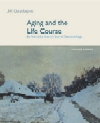1. The American Association of Retired Persons (http://research.aarp.org/general/portmino.html) provides statistical information on older minorities. Go to the AARP's website
and read the article titled "A Portrait of Older Americans." Pay particular
attention to the education, employment, income status, and poverty of the older
Americans described in the article. Then answer the following questions: - How does the average educational level of blacks compare to that of whites,
Hispanics, and Native Americans?
- Compare the employment of Native Americans over age 65 to that of blacks,
whites, and Asian/Pacific Islanders over age 65.
- Compare the median income of elderly Hispanics to that of elderly whites,
blacks, and Asian/Pacific Islanders.
- What percentage of Asian/Pacific Islanders live below the poverty level?
- In terms of poverty, how do Asian/Pacific Islander women age 65 and over
compare to white women age 65 and over?
- What percentage of the Native American population is over age 65? What percentage
is over age 75?
2. The National Academy of Social Insurance (http://www.nasi.org/)
contributes to the debate over the future of Social Security by presenting information
and briefs on the retirement program. Go to the academy's website and link to
Social Security Q's and A's to answer the first three questions that follow;
then link to Social Security Brief number 9 ("Widows, Poverty, and Social
Security") to answer the last question. - About how many Americans receive monthly Social Security benefits?
- How are Social Security benefits paid for?
- Why are Social Security benefits projected to cost more in the future?
- Summarize in your own words what the brief says about poverty among elderly
widows.
3. The American Federation of Labor and Congress of Industrial Organizations
(AFL-CIO) is the federation of America's labor unions. The AFL-CIO represents
more than 13 million working men and women. One of their fact sheets, "It's
High Time—Past Time—for Women of Color to Earn Equal Pay" provides valuable
information on gender and race inequality in the workplace. Go to the site (http://www.aflcio.org/women/f_color.htm)
and read the fact sheet. Then answer the following questions: - What percentage of all working women earn more than $75,000 a year?
What percentage of African American women and Latinas earn more than $75,000
a year?
- In 1996, women were paid how much for every dollar men received?
- African American women earn what percentage of what men earn?
- What are the primary occupations for African American women? Latinas?
- Discuss what the fact sheet tells us about women and pension plans.
4. The Center on Aging at the University of Missouri, Kansas City, (http://iml.umkc.edu/casww/hispanic.htm)
provides a great deal of information about Hispanic elderly. Read the information,
and answer the following questions: - Summarize, in your own words, what the article tells us about Social
Security and the Hispanic elderly.
- Why are the Hispanic elderly at risk for being preyed upon by others?
- What kind of living situation is common among Hispanic elderly?
- What is the most serious concern for Hispanic elderly? Explain.
- What view of aging is typically held by Mexican Americans?
|



 2002 McGraw-Hill Higher Education
2002 McGraw-Hill Higher Education